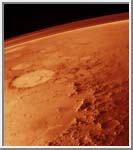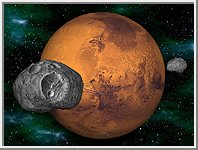NASA's "biggest discovery..."
 A glorious discovery says astronomer Carl Sagan of Mars life signs discovery
A glorious discovery says astronomer Carl Sagan of Mars life signs discovery
(13 sec. /265K AIFF or WAV sound)


 Martian Atmosphere
Martian Atmosphere
This oblique image taken by the Viking orbiter spacecraft shows a thin band of the Martian
atmosphere. This image looks northeast across the Argyre basin. The Argyre basin is about 600 kilometers across with a rugged
rim of about 500 kilometers in width.
 Scientists to expect life on Mars had to do with the apparent seasonal color changes on the planet's surface. This phenomenon
led to speculation that conditions might support a bloom of Martian vegetation during the warmer months and cause plant life
to become dormant during colder periods.
Scientists to expect life on Mars had to do with the apparent seasonal color changes on the planet's surface. This phenomenon
led to speculation that conditions might support a bloom of Martian vegetation during the warmer months and cause plant life
to become dormant during colder periods.

Mars is the fourth planet from the Sun and is commonly referred to as the Red Planet. The rocks, soil and sky have a red
or pink hue. The distinct red color was observed by stargazers throughout history. It was given its name by the Romans in
honor of their god of war. Other civilizations have had similar names. The ancient Egyptians named the planet Her Descher
meaning the red one.

